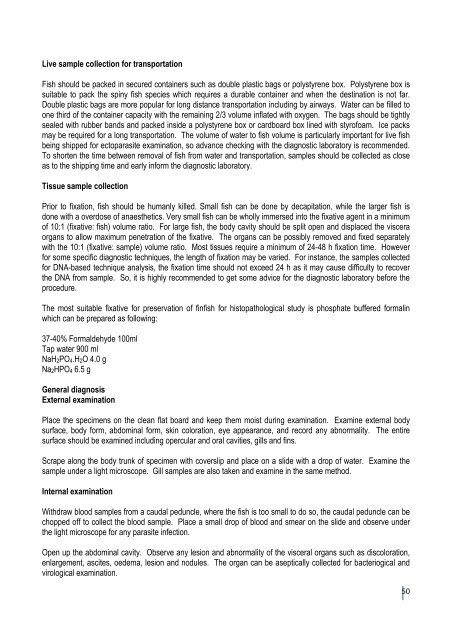Training of Trainers - Library - Network of Aquaculture Centres in ...
Training of Trainers - Library - Network of Aquaculture Centres in ...
Training of Trainers - Library - Network of Aquaculture Centres in ...
- No tags were found...
You also want an ePaper? Increase the reach of your titles
YUMPU automatically turns print PDFs into web optimized ePapers that Google loves.
Live sample collection for transportationFish should be packed <strong>in</strong> secured conta<strong>in</strong>ers such as double plastic bags or polystyrene box. Polystyrene box issuitable to pack the sp<strong>in</strong>y fish species which requires a durable conta<strong>in</strong>er and when the dest<strong>in</strong>ation is not far.Double plastic bags are more popular for long distance transportation <strong>in</strong>clud<strong>in</strong>g by airways. Water can be filled toone third <strong>of</strong> the conta<strong>in</strong>er capacity with the rema<strong>in</strong><strong>in</strong>g 2/3 volume <strong>in</strong>flated with oxygen. The bags should be tightlysealed with rubber bands and packed <strong>in</strong>side a polystyrene box or cardboard box l<strong>in</strong>ed with styr<strong>of</strong>oam. Ice packsmay be required for a long transportation. The volume <strong>of</strong> water to fish volume is particularly important for live fishbe<strong>in</strong>g shipped for ectoparasite exam<strong>in</strong>ation, so advance check<strong>in</strong>g with the diagnostic laboratory is recommended.To shorten the time between removal <strong>of</strong> fish from water and transportation, samples should be collected as closeas to the shipp<strong>in</strong>g time and early <strong>in</strong>form the diagnostic laboratory.Tissue sample collectionPrior to fixation, fish should be humanly killed. Small fish can be done by decapitation, while the larger fish isdone with a overdose <strong>of</strong> anaesthetics. Very small fish can be wholly immersed <strong>in</strong>to the fixative agent <strong>in</strong> a m<strong>in</strong>imum<strong>of</strong> 10:1 (fixative: fish) volume ratio. For large fish, the body cavity should be split open and displaced the visceraorgans to allow maximum penetration <strong>of</strong> the fixative. The organs can be possibly removed and fixed separatelywith the 10:1 (fixative: sample) volume ratio. Most tissues require a m<strong>in</strong>imum <strong>of</strong> 24-48 h fixation time. Howeverfor some specific diagnostic techniques, the length <strong>of</strong> fixation may be varied. For <strong>in</strong>stance, the samples collectedfor DNA-based technique analysis, the fixation time should not exceed 24 h as it may cause difficulty to recoverthe DNA from sample. So, it is highly recommended to get some advice for the diagnostic laboratory before theprocedure.The most suitable fixative for preservation <strong>of</strong> f<strong>in</strong>fish for histopathological study is phosphate buffered formal<strong>in</strong>which can be prepared as follow<strong>in</strong>g:37-40% Formaldehyde 100mlTap water 900 mlNaH 2 PO 4 .H 2 O 4.0 gNa 2 HPO 4 6.5 gGeneral diagnosisExternal exam<strong>in</strong>ationPlace the specimens on the clean flat board and keep them moist dur<strong>in</strong>g exam<strong>in</strong>ation. Exam<strong>in</strong>e external bodysurface, body form, abdom<strong>in</strong>al form, sk<strong>in</strong> coloration, eye appearance, and record any abnormality. The entiresurface should be exam<strong>in</strong>ed <strong>in</strong>clud<strong>in</strong>g opercular and oral cavities, gills and f<strong>in</strong>s.Scrape along the body trunk <strong>of</strong> specimen with coverslip and place on a slide with a drop <strong>of</strong> water. Exam<strong>in</strong>e thesample under a light microscope. Gill samples are also taken and exam<strong>in</strong>e <strong>in</strong> the same method.Internal exam<strong>in</strong>ationWithdraw blood samples from a caudal peduncle, where the fish is too small to do so, the caudal peduncle can bechopped <strong>of</strong>f to collect the blood sample. Place a small drop <strong>of</strong> blood and smear on the slide and observe underthe light microscope for any parasite <strong>in</strong>fection.Open up the abdom<strong>in</strong>al cavity. Observe any lesion and abnormality <strong>of</strong> the visceral organs such as discoloration,enlargement, ascites, oedema, lesion and nodules. The organ can be aseptically collected for bacteriogical andvirological exam<strong>in</strong>ation.50
















